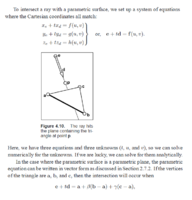You are using an out of date browser. It may not display this or other websites correctly.
You should upgrade or use an alternative browser.
You should upgrade or use an alternative browser.
Ray Rectangle intersection
- Thread starter markraz
- Start date
Cubist
Senior Member
- Joined
- Oct 29, 2019
- Messages
- 1,667
Here's a link to the previous thread.
If the quad exists in a plane, then yes, beta and gamma can be calculated and then used to determine if there is an intersection with the quad. BUT USUALLY the quad does not exist in a plane, therefore this technique is (probably) hardly used.
In other words, if the quad has the four vertices a,b,c,f then f is not always in the plane of triangle abc. This is especially true for curvy surfaces. Therefore the quad is often dealt with as being made from two distinct triangles. Intersections would be computed separately for these two triangles.
However quads are often used in 3d modelling in preference to triangles because they subdivide much nicer than triangles (the rendering package can automatically create finer-looking surfaces more easily) and also texture coordinates stretch better across quads than triangles. There may be more advantages than this!
If the quad exists in a plane, then yes, beta and gamma can be calculated and then used to determine if there is an intersection with the quad. BUT USUALLY the quad does not exist in a plane, therefore this technique is (probably) hardly used.
In other words, if the quad has the four vertices a,b,c,f then f is not always in the plane of triangle abc. This is especially true for curvy surfaces. Therefore the quad is often dealt with as being made from two distinct triangles. Intersections would be computed separately for these two triangles.
However quads are often used in 3d modelling in preference to triangles because they subdivide much nicer than triangles (the rendering package can automatically create finer-looking surfaces more easily) and also texture coordinates stretch better across quads than triangles. There may be more advantages than this!
markraz
Full Member
- Joined
- Feb 19, 2014
- Messages
- 338
thanks makes senseHere's a link to the previous thread.
If the quad exists in a plane, then yes, beta and gamma can be calculated and then used to determine if there is an intersection with the quad. BUT USUALLY the quad does not exist in a plane, therefore this technique is (probably) hardly used.
In other words, if the quad has the four vertices a,b,c,f then f is not always in the plane of triangle abc. This is especially true for curvy surfaces. Therefore the quad is often dealt with as being made from two distinct triangles. Intersections would be computed separately for these two triangles.
However quads are often used in 3d modelling in preference to triangles because they subdivide much nicer than triangles (the rendering package can automatically create finer-looking surfaces more easily) and also texture coordinates stretch better across quads than triangles. There may be more advantages than this!

